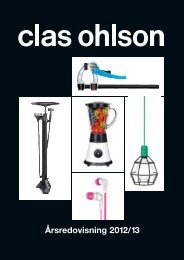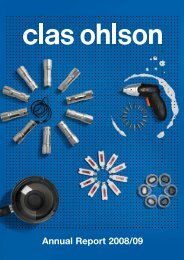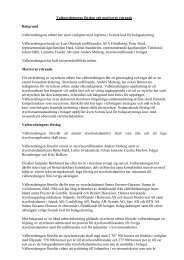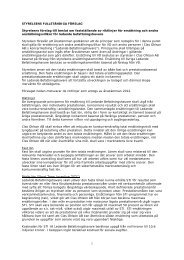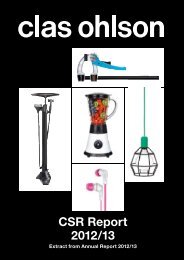Annual Report 2012/13 - Clas Ohlson
Annual Report 2012/13 - Clas Ohlson
Annual Report 2012/13 - Clas Ohlson
You also want an ePaper? Increase the reach of your titles
YUMPU automatically turns print PDFs into web optimized ePapers that Google loves.
Accounting policies and notes<br />
Amounts are in SEK M unless stated otherwise<br />
Note 1<br />
Accounting and<br />
valuation policies<br />
Compliance with standards and legislation<br />
The consolidated financial statements for <strong>Clas</strong> <strong>Ohlson</strong> have been prepared in<br />
accordance with the <strong>Annual</strong> Accounts Act, RFR 1 Supplementary Accounting<br />
Rules for Groups and International Financial <strong>Report</strong>ing Standards (IFRS)<br />
as approved by the EU. The financial statements were prepared in accordance<br />
with the cost method, apart from financial assets and liabilities measured<br />
at fair value.<br />
The annual accounts of the Parent Company have been prepared in<br />
accordance with the Swedish Companies Act and RFR 2 Accounting<br />
for Legal Entities. The same accounting policies are applied for the Group<br />
except in cases indicated under “Parent Company accounting policies”. The<br />
differences that occur between the policies applied for the Parent Company<br />
and Group derive from limitations on the possibilities to apply IFRS in the<br />
Parent Company resulting from the Swedish <strong>Annual</strong> Accounts Act.<br />
New and revised standards from 1 May <strong>2012</strong><br />
The IASB (International Accounting Standards Board) has issued new and<br />
revised IFRS and interpretations. However, they had no appreciable impact<br />
on the consolidated income statements and balance sheets.<br />
Forthcoming standards and revisions<br />
Standards, amendments and interpretations of current standards that have<br />
not yet come into effect and will not be applied in advance by the Group.<br />
IAS 19 “Employee benefits” has been revised, which means that the Group<br />
will refrain from using the “corridor method” and instead report all actuarial<br />
profits and losses in other comprehensive income as they arise. The Group<br />
intends to apply the revised standard for the financial year beginning 1 May<br />
20<strong>13</strong>. The amendment is deemed to have only a negligible effect on the<br />
Group’s profit and financial position.<br />
IFRS 9 “Financial instruments” replaces those parts of IAS 39 that are related<br />
to the classification and valuation of financial instruments. IFRS 9 states that<br />
financial assets are to be classified into two different categories; valuation at<br />
fair value or valuation at amortised cost. On the first accounting occasion,<br />
classification is determined on the basis of the company’s business model<br />
and the characteristic features in contractual cash flows. In the case of<br />
financial liabilities, there are no major changes compared with IAS 39. The<br />
Group intends to apply the new standard no later than the financial year<br />
beginning 1 May 2015 and has not yet evaluated the effects.<br />
IFRS <strong>13</strong> “Fair value measurement” provides an exact definition and joint<br />
source in IFRS for all fair value valuations and accompanying information.<br />
The Group intends to apply the new standard for the financial year beginning<br />
1 May 20<strong>13</strong> and has not yet assessed the effect on financial reporting.<br />
Other new standards, revisions and interpretations of existing standards have<br />
not yet come into effect and are not relevant for the Group or are deemed not<br />
to have any effect on consolidated profit or financial position.<br />
Basis of preparation<br />
The items included in the financial statements for the various units in the<br />
Group are valued in the currency used in the financial environment in which<br />
each company primarily operates (functional currency). The consolidated<br />
financial statements use Swedish kronor (SEK), which is the Parent<br />
Company’s functional currency and the reporting currency for the Group. All<br />
sums, unless otherwise stated, are rounded to the nearest million Swedish<br />
kronor plus one decimal point.<br />
The accounting policies for the Group indicated below have been applied<br />
consistently to all periods presented in the consolidated financial statements,<br />
unless otherwise stated. The Group’s accounting policies have been applied<br />
consistently to the reporting and consolidation of the Parent Company and<br />
subsidiaries.<br />
Estimates and assumptions<br />
Preparing the financial statements in accordance with IFRS requires<br />
management to make judgements, estimates and assumptions that impact<br />
upon the application of the accounting policies and the carrying amounts<br />
for assets, liabilities, income and expenses. These are based on historical<br />
experience and a number of other factors that appear reasonable under the<br />
prevailing conditions. The estimates and assumptions are reviewed regularly<br />
and are not judged to entail any significant risk of material adjustment of<br />
carrying amounts for assets and liabilities during the next financial year. Any<br />
changes to estimates are recognised in the period in which the change is<br />
made if the change has only impacted upon this period, or in the period in<br />
which the change is made and future periods if the change impacts upon<br />
both the current period and future periods. Further information on estimates<br />
and assumptions made is presented in Notes <strong>13</strong> and 22.<br />
Consolidated financial statements<br />
The consolidated financial statements pertain to the Parent Company and<br />
all companies over which the Parent Company directly or indirectly has<br />
controlling influence. The consolidated financial statements include the wholly<br />
owned subsidiaries <strong>Clas</strong> <strong>Ohlson</strong> AS, <strong>Clas</strong> <strong>Ohlson</strong> OY, <strong>Clas</strong> <strong>Ohlson</strong> Ltd (UK)<br />
and <strong>Clas</strong> <strong>Ohlson</strong> Ltd (Shanghai). The purchase method has been applied<br />
in preparing the consolidated financial statements. The annual accounts of<br />
the foreign subsidiaries have been translated using the current rate method,<br />
which means that assets, liabilities and equity have been translated from the<br />
functional currency to Swedish kronor at the exchange rate prevailing on the<br />
reporting date and income statements at the average monthly exchange<br />
rate for the year. The translation difference resulting from this, and resulting<br />
from the net investment having been translated at a different exchange rate<br />
at the end of the year than at the start of the year, is recognised in other<br />
comprehensive income. Intra-Group sales and intercompany profits have<br />
been eliminated in full from the consolidated financial statements.<br />
Translation of foreign currencies<br />
Transactions in foreign currencies are translated to the functional currency<br />
at the exchange rates applicable on the transaction date. Exchange-rate<br />
gains and losses arising from the payment of such transactions and from the<br />
translation of monetary assets and liabilities in foreign currency at the rate<br />
prevailing on the reporting date are recognised in profit or loss. An exception<br />
is when transactions represent hedging that fulfils the conditions for hedge<br />
accounting of cash flows and net investment in non-Swedish operations in<br />
which case gains/losses are recognised in other comprehensive income. For<br />
derivatives, refer to the section on financial instruments.<br />
Income<br />
The Group’s income is generated through the sale of products to consumers<br />
in accordance with the terms of sale. Sale income is reported net less VAT,<br />
returns, reservations for open purchase and discounts. Income is recognised<br />
at the time of sale/delivery to the customer, when material risks and benefits<br />
associated with ownership of the goods have been transferred to the<br />
purchaser. Sales to members of Club <strong>Clas</strong> are conducted in accordance<br />
with IFRIC <strong>13</strong>, in order to take into account club members’ earning of bonus<br />
points and the opportunity to utilise points saved in the form of bonus checks<br />
as payment in the future. Earnings are recognised through a reduction in<br />
turnover during the earnings period with a corresponding provision in the<br />
balance sheet. Interest income pertains to interest on bank balances. The<br />
income is recognised in the period to which the interest pertains.<br />
Income taxes<br />
Income taxes comprise current tax and deferred tax. Income taxes are<br />
recognised in profit or loss except when an underlying transaction is<br />
recognised directly in other comprehensive income including the associated<br />
tax effect. Current tax is tax that is due for payment or receipt in the<br />
current year, with application of the tax rates decided upon or in practice<br />
decided upon at the balance-sheet date, including adjustment of current tax<br />
attributable to prior periods. Deferred tax according to the balance-sheet<br />
method is calculated on all temporary differences arising between carrying<br />
amounts and values for tax purposes of assets and liabilities. Deferred tax<br />
is calculated with application of the tax rates and tax rules decided upon<br />
or in practice decided upon at the balance-sheet date. Deferred tax assets<br />
pertaining to deductible temporary differences and loss carryforwards are<br />
only recognised insofar as it is likely that it will be possible for these to be<br />
utilised. The value of deferred tax assets is reduced when it is no longer<br />
judged likely that it will be possible for them to be utilised. These temporary<br />
differences have mainly arisen from the depreciation of non-current assets,<br />
recognition of untaxed reserves and valuation of inventories.<br />
Deferred tax assets and liabilities are offset when there are legal offsetting<br />
rights for the particular tax assets and liabilities and when the deferred tax<br />
assets and liabilities pertain to taxes by the same tax authority and pertain to<br />
the same tax subject or different tax subjects and for which there is a plan to<br />
settle the balance through net payments.<br />
Assets<br />
Assets are recognised at cost less accumulated depreciation/amortisation<br />
and any accumulated impairment losses. Cost includes the purchase price<br />
64<br />
Accounts




